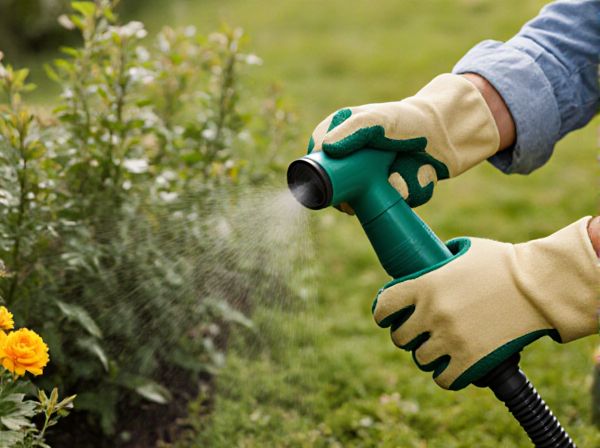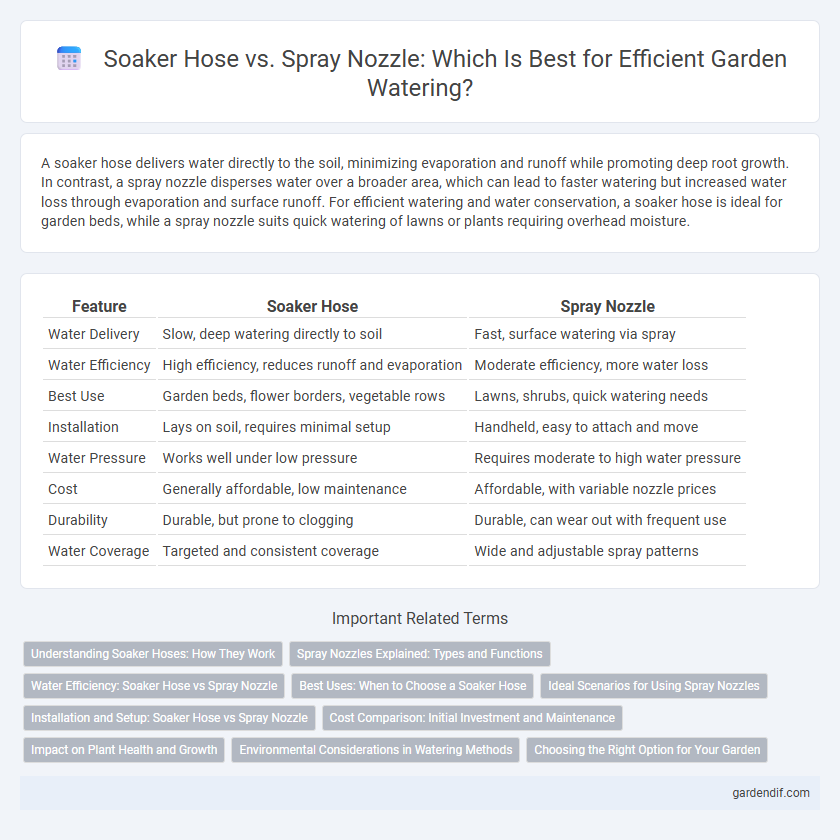
Soaker hose vs Spray nozzle Illustration
A soaker hose delivers water directly to the soil, minimizing evaporation and runoff while promoting deep root growth. In contrast, a spray nozzle disperses water over a broader area, which can lead to faster watering but increased water loss through evaporation and surface runoff. For efficient watering and water conservation, a soaker hose is ideal for garden beds, while a spray nozzle suits quick watering of lawns or plants requiring overhead moisture.
Table of Comparison
| Feature | Soaker Hose | Spray Nozzle |
|---|---|---|
| Water Delivery | Slow, deep watering directly to soil | Fast, surface watering via spray |
| Water Efficiency | High efficiency, reduces runoff and evaporation | Moderate efficiency, more water loss |
| Best Use | Garden beds, flower borders, vegetable rows | Lawns, shrubs, quick watering needs |
| Installation | Lays on soil, requires minimal setup | Handheld, easy to attach and move |
| Water Pressure | Works well under low pressure | Requires moderate to high water pressure |
| Cost | Generally affordable, low maintenance | Affordable, with variable nozzle prices |
| Durability | Durable, but prone to clogging | Durable, can wear out with frequent use |
| Water Coverage | Targeted and consistent coverage | Wide and adjustable spray patterns |
Understanding Soaker Hoses: How They Work
Soaker hoses deliver water directly to the soil through tiny porous holes, allowing slow, deep irrigation that minimizes evaporation and runoff. Unlike spray nozzles that disperse water above ground, soaker hoses ensure efficient moisture absorption by targeting plant roots, promoting healthier growth. Their design reduces water waste by evenly distributing water along the hose length, making them ideal for garden beds and landscaping.
Spray Nozzles Explained: Types and Functions
Spray nozzles come in various types, including fixed, adjustable, and oscillating, each designed to control water flow and coverage for different watering needs. Fixed nozzles deliver a steady spray pattern ideal for targeted watering, while adjustable nozzles allow users to change the spray intensity and shape for flexibility. Oscillating nozzles provide a sweeping motion to cover larger areas evenly, making them suitable for lawns and garden beds.
Water Efficiency: Soaker Hose vs Spray Nozzle
Soaker hoses deliver water directly to the soil through tiny pores, minimizing evaporation and runoff, resulting in up to 50% greater water efficiency compared to spray nozzles. Spray nozzles often disperse water over leaves and surrounding air, increasing water loss and requiring more frequent watering. For optimal water conservation, soaker hoses offer precise irrigation that supports deeper root absorption while reducing overall water usage.
Best Uses: When to Choose a Soaker Hose
Soaker hoses are ideal for deep watering of garden beds, vegetable patches, and flower borders, ensuring water seeps slowly into the soil and reaches plant roots efficiently. They reduce water waste by minimizing evaporation and runoff, making them perfect for drought-prone areas or water-restricted zones. Choose a soaker hose over a spray nozzle when uniform, low-pressure irrigation is needed for sustained moisture delivery to shrubs, perennials, or closely spaced plants.
Ideal Scenarios for Using Spray Nozzles
Spray nozzles are ideal for watering delicate plants, flower beds, and newly seeded lawns where precise water distribution is essential to prevent soil erosion and overwatering. They allow adjustable spray patterns and pressure control, catering to different plant types and garden layouts. Spray nozzles excel in situations requiring targeted watering and quick coverage of small to medium garden areas.
Installation and Setup: Soaker Hose vs Spray Nozzle
Soaker hoses require minimal installation, typically needing to be unrolled and connected directly to a water source with no additional tools, allowing water to seep slowly into the soil for deep irrigation. Spray nozzles demand a bit more setup, often attaching to a standard garden hose and offering adjustable spray patterns to target specific plants, which may require occasional adjustments for optimal coverage. The simplicity of soaker hoses makes them ideal for consistent watering with less effort, while spray nozzles provide more flexibility but involve more hands-on setup.
Cost Comparison: Initial Investment and Maintenance
Soaker hoses generally have a lower initial investment cost, ranging from $10 to $30 depending on length and quality, while spray nozzles typically cost between $15 and $50. Maintenance for soaker hoses is minimal, focusing mainly on occasional unclogging, whereas spray nozzles may require more frequent cleaning and replacement of washers or seals. Considering long-term durability, soaker hoses often last 3-7 years under regular use, while spray nozzles' moving parts might reduce their lifespan and increase maintenance expenses.
Impact on Plant Health and Growth
Soaker hoses deliver water directly to the soil, minimizing leaf wetness and reducing the risk of fungal diseases, thereby promoting healthier root development and stronger plant growth. Spray nozzles distribute water over the foliage, which can increase the chance of leaf diseases and uneven watering, potentially stressing plants and hindering optimal growth. Consistent soil moisture from soaker hoses enhances nutrient uptake and supports sustained plant vitality better than surface watering methods.
Environmental Considerations in Watering Methods
Soaker hoses minimize water waste by delivering moisture directly to the soil, reducing evaporation and runoff compared to spray nozzles. Spray nozzles often disperse water over a broader area, increasing evaporation and potential water loss, which can negatively impact water conservation efforts. Choosing soaker hoses supports sustainable gardening practices by promoting efficient water use and reducing environmental strain.
Choosing the Right Option for Your Garden
Soaker hoses deliver slow, deep watering directly to plant roots, reducing evaporation and water runoff, ideal for garden beds and established plants. Spray nozzles offer adjustable water patterns and pressure, making them versatile for watering delicate seedlings or larger lawn areas. Selecting between a soaker hose and spray nozzle depends on your garden's specific needs, soil type, and plant varieties to ensure efficient and effective irrigation.
Soaker hose vs Spray nozzle Infographic

 gardendif.com
gardendif.com